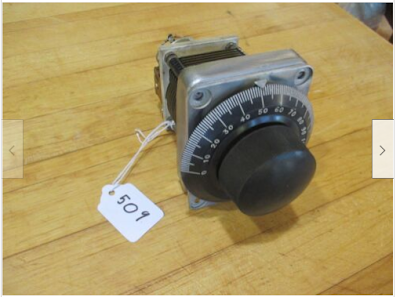In an effort to stop the slaughter of innocent Heath QF-1s (for their very nice variable capacitors), I bought this thing on e-bay. Here is the info I have:
I checked the resonance of the cap and the coil: It tunes from about 10.140 MHz to about 13 MHz. The cap is nice -- brass vanes and with the linear tuning shape. I don't know about it being from a Hartley oscillator -- no signs of a tickler coil. There seems to be some sort of a pass-through cap from "Faradon" of Camden N.J.
Update:
It tunes from about 9 to 138 pf. The coil that it had on the back of the cap is about 1.6 uH and is tapped (Hartley style). The capacitor is marked on the back: "Licensed Under Pats. MC 15257781258423"
From the e-bay ad:
"Here's a great project part. These were likely a VFO assembly for some RF equipment from the late 1920's or 30's. Essentially it's 4" Type A Velvet Vernier dial (standard 5:1 reduction drive) with a variable capacitor. The variable condenser is a high quality ceramic frame with brass plates and looks suspiciously like a General Radio house part (also in Cambridge at that time). The variable condenser looks like a SLF shape or similar, about 135pF. It has a ceramic frame and has an insulated shaft, which was critical to keeping hand capacity down back then. It appears to be wired for a Hartley oscillator, probably 10 MHz+ give or take (not measured).
There is a rigid metal panel to which the vernier assembly is attached, and this in turn supports the condenser frame. I suppose you could just that in a project box with an appropriate sized hole for the shaft and have an instant shielded enclosure for a VFO, or maybe screw it to the side of a breadboard. You can also remove the vernier assembly from the panel and use it separately (e.g., to fix up an old NBD). Lots of possibilities.
There is a loose sheet-metal collar behind the rigid panel that friction-fit a (now missing) can that went over the whole assembly. It's easy enough to unscrew the front and remove this piece. Everything comes apart if you want, including the unobtainium dial pointer."
So where do you guys think this very nice cap came from? Who made it? Was it salvaged from a piece of radio gear? Does it appear in any of the old catalogs?

No comments:
Post a Comment